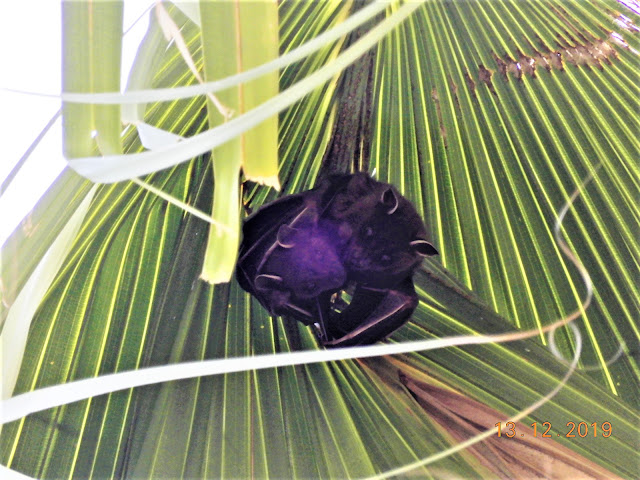(Original articles written for the Newsletter of Hong Kong Gardening Society)
Chinese New Year has just pasted quickly as
the impact of coronavirus disease spread across the boundary of Hong Kong. While someone is blaming bats as a vector of
the disease with many other similar virus-based pandemic, traditionally bat is
correlated with fortune “福” in Chinese culture due to the same pronunciation of the Chinese name
(i.e. “蝠”) of bat. One may easily
find symbols of bat in traditional Chinese decorations, e.g. in Fai-Chun
and paper-cut arts.
 |
| The roosting fronds (tents) are usually flipped downward |
Bats are not rare locally and there are
indeed more than 20 species. The largest
and one of the most common species (Short-nosed Fruit Bat; 短吻果蝠; Cynopterus
sphinx) can be seen easily at dusk in many parts of Hong Kong, especially
around where Chinese Fan Palm 蒲葵
(Livistona chinensis) is growing. Chinese Fan Palm is a popular palms in Hong
Kong. Although it is classified as an
introduced species, its natural distribution is across the whole south-east
China. The palm does not only provide
fruits for the bat (some birds as well), most importantly it is also where you
can find the bat roosting steadily under the palm-shape fronds. The bat, however, is picky while choosing a
palm for roosting. It does not prefer ones
which are at disturbed areas. But if you
house one Chinese Fan Palm (tall enough for the bat’s own safety) at a quiet corner
in your garden, you may be able to provide a good home for this little fortune!
 |
| A pair of Short-nosed Fruit Bat under Livistona chinese frond |
 |
| Chewed and bended fronds |
If you do not have a garden, you can try looking
for any bitten and bended fronds of the palms that always flipped down – this
is how the bat makes for their own protective “tents”. You may find a solitary bat or a group under
a single frond. Anyway, the palm is more
common than the bat (Chinese Fan Palm is planted everywhere – parks, roadside,
housing developments - in Hong Kong and also self-seeded) - so it always
requires some effort to get fortune.
Just give thanks when we come across it. Do not eat.



